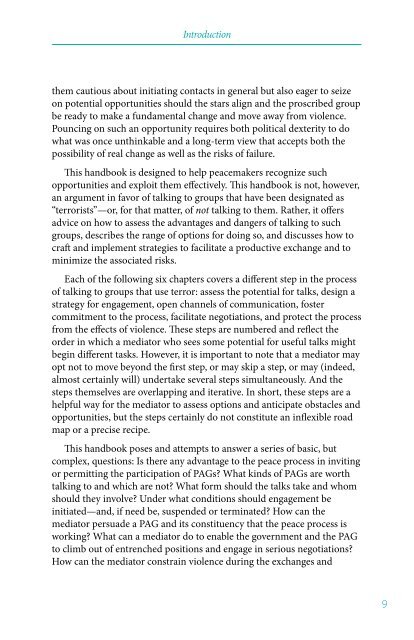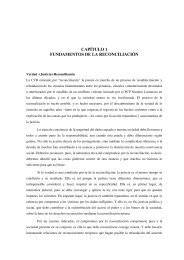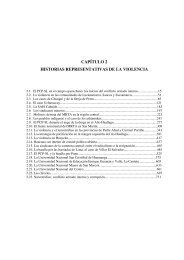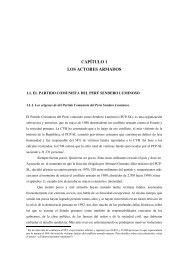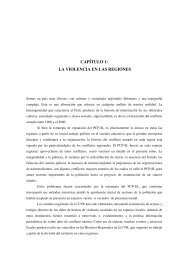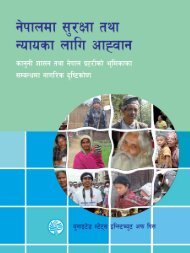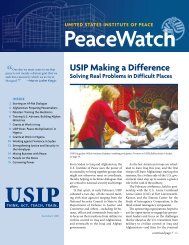Talking to Groups that Use Terror.pdf - United States Institute of Peace
Talking to Groups that Use Terror.pdf - United States Institute of Peace
Talking to Groups that Use Terror.pdf - United States Institute of Peace
You also want an ePaper? Increase the reach of your titles
YUMPU automatically turns print PDFs into web optimized ePapers that Google loves.
Introductionthem cautious about initiating contacts in general but also eager <strong>to</strong> seizeon potential opportunities should the stars align and the proscribed groupbe ready <strong>to</strong> make a fundamental change and move away from violence.Pouncing on such an opportunity requires both political dexterity <strong>to</strong> dowhat was once unthinkable and a long-term view <strong>that</strong> accepts both thepossibility <strong>of</strong> real change as well as the risks <strong>of</strong> failure.This handbook is designed <strong>to</strong> help peacemakers recognize suchopportunities and exploit them effectively. This handbook is not, however,an argument in favor <strong>of</strong> talking <strong>to</strong> groups <strong>that</strong> have been designated as“terrorists”—or, for <strong>that</strong> matter, <strong>of</strong> not talking <strong>to</strong> them. Rather, it <strong>of</strong>fersadvice on how <strong>to</strong> assess the advantages and dangers <strong>of</strong> talking <strong>to</strong> suchgroups, describes the range <strong>of</strong> options for doing so, and discusses how <strong>to</strong>craft and implement strategies <strong>to</strong> facilitate a productive exchange and <strong>to</strong>minimize the associated risks.Each <strong>of</strong> the following six chapters covers a different step in the process<strong>of</strong> talking <strong>to</strong> groups <strong>that</strong> use terror: assess the potential for talks, design astrategy for engagement, open channels <strong>of</strong> communication, fostercommitment <strong>to</strong> the process, facilitate negotiations, and protect the processfrom the effects <strong>of</strong> violence. These steps are numbered and reflect theorder in which a media<strong>to</strong>r who sees some potential for useful talks mightbegin different tasks. However, it is important <strong>to</strong> note <strong>that</strong> a media<strong>to</strong>r mayopt not <strong>to</strong> move beyond the first step, or may skip a step, or may (indeed,almost certainly will) undertake several steps simultaneously. And thesteps themselves are overlapping and iterative. In short, these steps are ahelpful way for the media<strong>to</strong>r <strong>to</strong> assess options and anticipate obstacles andopportunities, but the steps certainly do not constitute an inflexible roadmap or a precise recipe.This handbook poses and attempts <strong>to</strong> answer a series <strong>of</strong> basic, butcomplex, questions: Is there any advantage <strong>to</strong> the peace process in invitingor permitting the participation <strong>of</strong> PAGs? What kinds <strong>of</strong> PAGs are worthtalking <strong>to</strong> and which are not? What form should the talks take and whomshould they involve? Under what conditions should engagement beinitiated—and, if need be, suspended or terminated? How can themedia<strong>to</strong>r persuade a PAG and its constituency <strong>that</strong> the peace process isworking? What can a media<strong>to</strong>r do <strong>to</strong> enable the government and the PAG<strong>to</strong> climb out <strong>of</strong> entrenched positions and engage in serious negotiations?How can the media<strong>to</strong>r constrain violence during the exchanges and9


